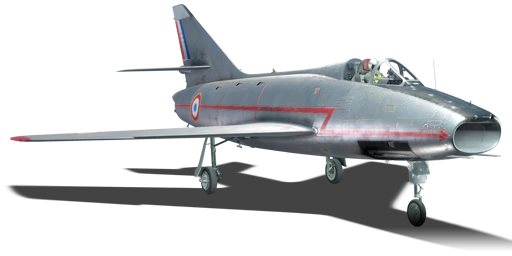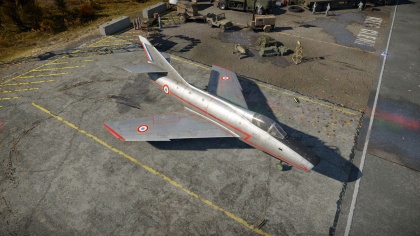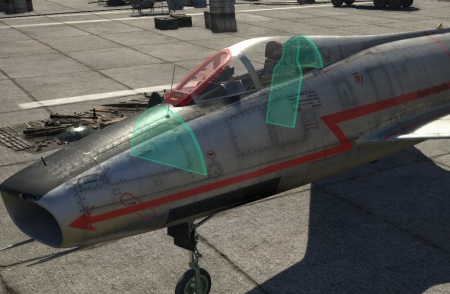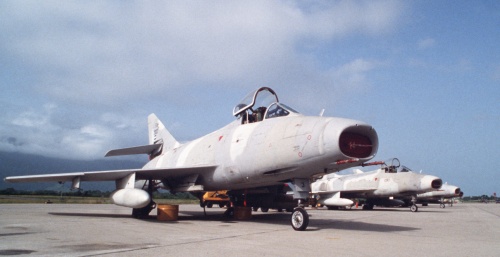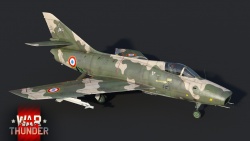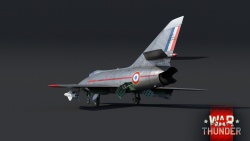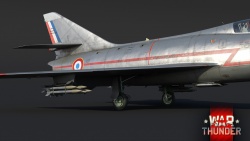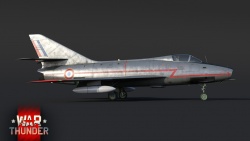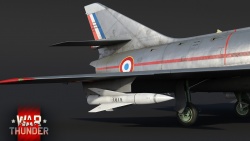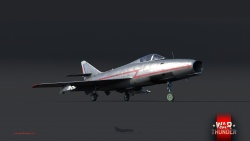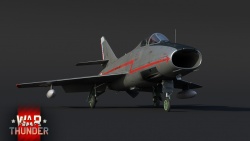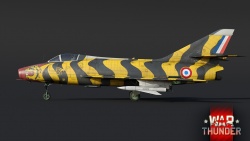Difference between revisions of "Super Mystere B2"
m (→External links) |
m (→Suspended armament: added image.) |
||
| Line 150: | Line 150: | ||
{{main|AN-M64A1 (500 lb)|AN-M65A1 Fin M129 (1,000 lb)|T10 151|SNEB Type 23|AS-20}} | {{main|AN-M64A1 (500 lb)|AN-M65A1 Fin M129 (1,000 lb)|T10 151|SNEB Type 23|AS-20}} | ||
{{main|AIM-9B|AA-20}} | {{main|AIM-9B|AA-20}} | ||
| − | + | [[File:SuperMystere_honduras_001.jpg|500px|thumb|right|French-built '''{{PAGENAME}}''' fighters of the Honduran Air Force. Note the light grey camoflauge utilised compared to the typical French woodland style greens and browns.]] | |
The '''''{{PAGENAME}}''''' can be outfitted with the following ordnance: | The '''''{{PAGENAME}}''''' can be outfitted with the following ordnance: | ||
* 2 х 500 lb AN-M64A1 bombs (1,000 lb total) | * 2 х 500 lb AN-M64A1 bombs (1,000 lb total) | ||
| Line 186: | Line 186: | ||
* SNEB Type 23 rockets: The SNEB Type 23 rockets area available in greater quantities than the T10 151's with numbers as great as 73. For air-to-air, these rockets are most effective when used against bomber aircraft as they are typically slower and a larget target, perfect for a large salvo launch of type 23 rockets. When encountering lighter ground targets which are in relatively close proximity to each other large amounts of the SNEB Type 23 rockets can cover large areas of ground with exploding rockets highly increasing the chances of hitting one or more targets in a single pass. These rockets can be considered an area deniability weapon as when salvos are fired at an airfield, aircraft attempting to land intent on capturing the runway will most likely power up and abort the landing or risk the destruction of their aircraft. | * SNEB Type 23 rockets: The SNEB Type 23 rockets area available in greater quantities than the T10 151's with numbers as great as 73. For air-to-air, these rockets are most effective when used against bomber aircraft as they are typically slower and a larget target, perfect for a large salvo launch of type 23 rockets. When encountering lighter ground targets which are in relatively close proximity to each other large amounts of the SNEB Type 23 rockets can cover large areas of ground with exploding rockets highly increasing the chances of hitting one or more targets in a single pass. These rockets can be considered an area deniability weapon as when salvos are fired at an airfield, aircraft attempting to land intent on capturing the runway will most likely power up and abort the landing or risk the destruction of their aircraft. | ||
| − | Thanks to the many different options of suspended armaments available to this aircraft, options and roles can be mixed and matched to the pilot's desires and the map's available targets, for either air-to-air combat, ground-attack combat or a mixed-bag of both. The {{PAGENAME}} can be a jack-of-all-trades and when coming up against one, the attacking pilot making assumptions may find themselves rethinking the attack when the {{PAGENAME}} turns the tables. | + | Thanks to the many different options of suspended armaments available to this aircraft, options and roles can be mixed and matched to the pilot's desires and the map's available targets, for either air-to-air combat, ground-attack combat or a mixed-bag of both. The {{PAGENAME}} can be a jack-of-all-trades and when coming up against one, the attacking pilot making assumptions may find themselves rethinking the attack when the {{PAGENAME}} turns the tables. |
== Usage in battles == | == Usage in battles == | ||
Revision as of 00:57, 23 October 2019
Contents
| This page is about the French jet fighter Super Mystere B2. For other uses, see Mystere (Family). |
Description
The Super Mystere B2 is a rank VI French jet fighter
with a battle rating of 9.0 (AB/RB/SB). It was introduced in Update 1.87 "Locked On".
The French Super Mystère was designed, developed and manufactured by Dassault Aviation as a multi-role fighter-bomber, a niche which would later encompass such aircraft as the F-105 Thunderchief and the F-4C Phantom which could not be pigeon-holed into one type of combat role. The multi-role function created a combat multiplier with just one aircraft instead of needing several specialized aircraft to do certain jobs. A last-minute change of targets could allow for weapons change or multiple types of ordnance can be carried to take on one or more roles during a combat run.
The Super Mystère is the culminating aircraft in a series of four other predecessors before it. Initially starting with the Dassault Ouragan, modifications and upgrades led to the Mystère II, Mystère III and Mystère IV. The Mystère series fighters while quick, could not go super-sonic except during a dive whereas, like many of the newer aircraft of the time, the Super Mystère had swept wings which allowed it to achieve supersonic flight during level flight. Another plus to the Super Mystère was that its turbojet engine was equipped with an afterburner which earlier Mystère fighters did not have.
The Super Mystere B2 can fulfil a multi-role function by either being a fighter-interceptor or a fighter-bomber. Outfitted with the afterburner, this fighter can easily become an interceptor either going after fighters or bombers. This fighter is outfitted with two 30 mm DEFA 552 autocannons as its main weapon and also can be fitted with SNEB type 23 rockets, T10 151 rockets, AA-20 missiles or AIM-9B Sidewinder missiles for air to air combat. Though the rockets and missiles are not a guarantee that the enemy will be hit and go down, always be ready to follow up with the DEFA 552 as the enemy fighter will most likely be in an energy-drained situation and a relatively easy target to mop up with the autocannon.
Though relatively nimble and quick when outfitted for air-to-air combat, things change when switched to ground-pounding. The speed and manoeuvrability trade-off is worth it as this fighter converted to a bomber can carry a hefty payload for an aircraft its size. Ground-attack rockets are a good option especially with the T10 151 or SNEB Type 23 to focus on attacking lighter clustered targets. For direct bomb-to-target ordnance, the aircraft has the choice of outfitting either 1,000 or 2,000 lbs of bombs, enough to do serious damage to larger ships, hardened targets and bases.
The Super Mystere B2 is a fighter/interceptor/bomber which newer pilots to supersonic jets can master quickly, especially with a playstyle they are comfortable with. Though not the fastest fighter, it has speed enough to not get out of control and depending on the playstyle of the pilot, air-to-air combat, air-to-ground combat or a mix of both are available options depending on the suspended weapons loadout allowing the pilot to take to the skies to destroy enemy targets and aid in whittling down the enemies tickets towards victory.
General info
Flight Performance
Describe how the aircraft behaves in the air. Speed, manoeuvrability, acceleration and allowable loads - these are the most important characteristics of the vehicle.
| Characteristics | |||||||
|---|---|---|---|---|---|---|---|
| Stock | |||||||
| Max Speed (km/h at 0 m - at sea level) |
Max altitude (meters) |
Turn time (seconds) |
Rate of climb (meters/second) |
Take-off run (meters) | |||
| AB | RB | AB | RB | AB | RB | ||
| 1183 | 1165 | 17000 | 32.1 | 33.2 | 50.2 | 49.4 | 800 |
| Upgraded | |||||||
| Max Speed (km/h at 0 m - at sea level) |
Max altitude (meters) |
Turn time (seconds) |
Rate of climb (meters/second) |
Take-off run (meters) | |||
| AB | RB | AB | RB | AB | RB | ||
| ??? | ??? | 17000 | ??.? | ??.? | ??.? | ??.? | 800 |
Details
| Features | ||||
|---|---|---|---|---|
| Combat flaps | Take-off flaps | Landing flaps | Air brakes | Arrestor gear |
| ✓ | ✓ | ✓ | ✓ | X |
| Limits | ||||
|---|---|---|---|---|
| Wing-break speed (km/h) |
Gear limit (km/h) |
Combat flaps (km/h) |
Max Static G | |
| + | - | |||
| 620 | ~10 | ~3 | ||
| Optimal velocities | |||
|---|---|---|---|
| Ailerons (km/h) |
Rudder (km/h) |
Elevators (km/h) |
Radiator (km/h) |
| < 640 | < 610 | < 590 | N/A |
| Compressor (RB/SB) | ||
|---|---|---|
| Setting 1 | ||
| Optimal altitude | 100% Engine power | WEP Engine power |
| 0 m | 3,128 kgf | N/A |
Survivability and armour
- 14 mm steel plate - front cockpit
- 14 mm steel plate - behind the pilot's seat
- 14 mm steel plate - behind the pilot's headrest (the two 14 mm plates butt up against each other effectively providing 28 mm total or 30 mm when adjusting for constructional armour slope angle
- 40 mm bulletproof glass in canopy windshield
The Super Mystere B2 is a fighter which is in a unique position of being in a transitional period between the end of World War II and the Vietnam Era. Still holding onto some of the facets of a WW II fighter which later fighters eliminate, this French fighter has a decent amount of armour to protect the pilot, something later jets forgo to allow for more speed and to carry more ordnance. The pilot of the Super Mystere B2 is well protected from the front with a bulletproof windscreen which due to its slope has an effective thickness of 67 mm. The huge gaping hole in the front of the aircraft sucking in copious amounts of air for the engine presents a problem, as, during head-on attacks, bullets potentially could fly right into the air intake and penetrate the cockpit with very little resistance. To combat this problem, the fighter has a 14 mm steel plate which blocks the entire front area of the cockpit area, protecting the pilot but leaving enough space for the air to get to the engine.
During attacks from behind, the pilot is again protected by two plates, one directly behind the seat and a second one behind the headrest with the combination of the two plates providing around 30 mm of protection. The rest of the critical components of the aircraft are left relatively unprotected with many fuel tanks in the wings, more in the fuselage surrounding the engine and the engine itself. When attacking this aircraft, the wings and centre fuselage provide the best areas of attack as they are most likely to hit a critical component or blow off a wing. Pilot sniping may be effective from the side, but trying to line up that shot will be difficult and the attacking pilot will have a better chance to hit the larger areas of the wings or fuselage.
Armaments
Offensive armament
The Super Mystere B2 is armed with:
- 2 x 30 mm DEFA 552 cannons, chin-mounted (150 rpg = 300 total)
The Super Mystere B2 like many of the fighters of the time got away from machine guns and were outfitted with autocannons, in this case, 30 mm DEFA 552 cannons. Lessons learned the hard way in other aircraft resulted in the lower fuselage under where the cockpit is, but behind the air-intake to the aircraft. This resulting location provided optimal fire control as convergence is not an issue, however, the pilot must still correct for bullet drop for the 30 mm rounds. Also, exhaust gasses from the cannons were not anywhere near air intake and did not threaten to choke out the engine as happened with the Hunter F.6 or the MiG-19 fighters when their guns were fired and exhaust gasses were ingested into the air intakes. The two DEFA 552 cannons only have 150 rounds per gun which require the pilot to exercise trigger control so not to waste ammunition.
Suspended armament
The Super Mystere B2 can be outfitted with the following ordnance:
- 2 х 500 lb AN-M64A1 bombs (1,000 lb total)
- 2 х 1000 lb AN-M65A1 Fin M129 bombs (2,000 lb total)
- 12 х T10 151 rockets
- 38 х SNEB type 23 rockets
- 35 х SNEB type 23 rockets
- 2 х AA-20 Nord air-to-air missiles
- 2 х AS-20 Nord rockets
- 2 х AIM-9B Sidewinder air-to-air missiles
- 2 х AA-20 Nord air-to-air missiles + 35 х SNEB type 23 rockets
- 2 х AS-20 Nord rockets + 35 х SNEB type 23 rockets
- 2 х 500 lb AN-M64A1 bombs + 35 х SNEB type 23 rockets (1,000 lb total)
- 2 х 1000 lb AN-M65A1 Fin M129 bombs + 35 х SNEB type 23 rockets (2,000 lb total)
- 12 х T10 151 rockets + 35 х SNEB type 23 rockets
- 73 х SNEB type 23 rockets
- 35 х SNEB type 23 rockets + 2 х AIM-9B Sidewinder air-to-air missiles
The Super Mystere B2 was built to be a battlewagon of an aircraft, capable of fulfilling different roles as the mission dictated. This fighter has access to a multitude of both French and US armaments to round out its capabilities no matter what map it spawns on whether it is an air-to-air attack, ground-attack or both.
- Air-to-air attack
Most maps in War Thunder lend themselves to cater to air-to-air attacks, especially on domination maps with battles to control airfields. For this purpose, the Super Mystere B2 and morph into the fighter-interceptor role and pursue fighters, attackers and bombers without discrimination. Specific weapons for air-to-air combat include:
- AIM-9B Sidewinder: The AIM-9B Sidewinder is an extremely effective short-range guided missile which acquires and maintains contact with its target through an IR lens on the head of the missile. Extremely quick and agile, this missile is very difficult to out-manoeuvre. Enemy fighters which out-manoeuvre this missile are typically left in a severely energy-depleted state, being an easy target to be eliminated with the firing aircraft's on-board DEFA 552 autocannons.
- AA-20 Nord: The AA-20, typically regarded as a stepping stone to future missiles, had many limitations in that it requires the pilot to guide the missile to its target through a command link. The missile's movement due to its fixed wings resulted in a steady roll rate, but guidance adjustments came through the combined efforts of the control system and gyroscope. Not the easy fire-and-forget style like the Sidewinder, this missile will take some skill and much practice to master.
- Air-to-ground attack
Converting this fighter-interceptor to a fighter-bomber is as easy as changing out the suspended armament types. Options here range from using dropped munition bombs or unguided rockets, fired either singly or in salvos depending on the type.
- AS-20 Nord: The AS-20 is a modified version of the AA-20 to convert it to an Air-to-Ground missile, largely the main change was adding a larger warhead and installing an impact fuze. Limitations for this missile are the same as the AA-20 being a command guidance control missile which results in the pilot's concentration during the launch and contact with the target phase resulting in a vulnerable aircraft.
- T10 151 rockets: These are unguided 68 mm rockets which are launched from a rocket pod. Typically rockets of this size are ineffective when fired singly, this rocket should be fired in salvos where chances are increased that one or more will hit the target. Best used against lighter vehicles, anti-aircraft guns and aircraft sitting on the airfield.
- 500 lb AN-M64A1 bomb: The AN-M64A1 is a good multi-purpose bomb which can have an effect on bases, but should be reserved for more hardened targets like fortified pill-boxes, medium to large tanks or vehicles which are clustered together.
- 1,000 lb AN-M65A1 Fin-M129 bomb: The AN-M51A1 is a heavy-hitting bomb which can do some serious damage to a base or other hardened targets. Though a waste against smaller and lighter targets, it can be effective when used against clustered targets (sometimes overkill).
- Multi-use attack
In combination with the 30 mm DEFA 552 cannons, the Super Mystere B2 can be outfitted with SNEB type 23 unguided rockets which can be utilised with great effect both in the air and on the ground.
- SNEB Type 23 rockets: The SNEB Type 23 rockets area available in greater quantities than the T10 151's with numbers as great as 73. For air-to-air, these rockets are most effective when used against bomber aircraft as they are typically slower and a larget target, perfect for a large salvo launch of type 23 rockets. When encountering lighter ground targets which are in relatively close proximity to each other large amounts of the SNEB Type 23 rockets can cover large areas of ground with exploding rockets highly increasing the chances of hitting one or more targets in a single pass. These rockets can be considered an area deniability weapon as when salvos are fired at an airfield, aircraft attempting to land intent on capturing the runway will most likely power up and abort the landing or risk the destruction of their aircraft.
Thanks to the many different options of suspended armaments available to this aircraft, options and roles can be mixed and matched to the pilot's desires and the map's available targets, for either air-to-air combat, ground-attack combat or a mixed-bag of both. The Super Mystere B2 can be a jack-of-all-trades and when coming up against one, the attacking pilot making assumptions may find themselves rethinking the attack when the Super Mystere B2 turns the tables.
Usage in battles
Describe the tactics of playing in an aircraft, the features of using vehicles in a team and advice on tactics. Refrain from creating a "guide" - do not impose a single point of view, but instead, give the reader food for thought. Examine the most dangerous enemies and give recommendations on fighting them. If necessary, note the specifics of the game in different modes (AB, RB, SB).
Modules
| Tier | Flight performance | Survivability | Weaponry | |||
|---|---|---|---|---|---|---|
| I | Fuselage repair | Compressor | Offensive 30 mm | ALCAN 502 500 | Matra Type 61 | |
| II | New boosters | Airframe | ALCAN 502 1000 | Matra Type 116 | ||
| III | Wings repair | Engine | New 30 mm cannons | Nord AA.20 | Matra Type 105 | |
| IV | G-suit | Cover | Nord AS.20 | AIM-9B | ||
Pros and cons
Pros:
- Equipped with afterburner, can go supersonic in level flight
- Multi-role, fighter/interceptor, fighter/bomber or mixed options
- Multiple ordnance options with rockets, bombs and missiles
Cons:
- Dual autocannon, only 150 rounds per cannon
- Slower than many contemporary fighters
History
The Super Mystère was the final aircraft of the Mystère family of jet fighters, whose development history began with the creation of the Dassault Ouragan in the late 1940s. Featuring a modified design over the preceding Mystère 4 and being fitted with the new Rolls-Royce Avon afterburning turbojet engine, the resulting Super Mystère B.1 prototype became the first French supersonic jet fighter after conducting its maiden flight in March 1955.
Following the successful maiden flight of the prototype of the Super Mystère, a more refined production version of the machine was created shortly afterwards. Known as the Super Mystère B.2, the production version of the aircraft featured the SNECMA Atar 101G engine, compared to the Rolls-Royce Avon found on the prototype.
The Super Mystère B.2 entered production in 1956, with an initial contract for 150 aircraft being signed. By the end of production in 1959, around 180 Super Mystère B.2s were built out of a planned 370 units.
Entering service with the French Air Force in 1957, the Super Mystère B.2 served with French units for a good two decades before being replaced by newer and more advanced machines. Apart from its own forces, the Super Mystère B.2 was also exported and used by foreign operators. Most notably, Israel fielded some 24 Super Mystères, which had successfully proven themselves in action during the Six-Day and Yom-Kippur wars.
As the Super Mystère was slowly being phased out of French and Israeli service, Israel sold around a dozen of its Super Mystères to Honduras. In service with Honduras, the Super Mystères undertook their final missions as part of actions against Nicaraguan forces during border skirmishes before being ultimately decommissioned in 1996.
- From Devblog
Media
See also
- Contemporary fighters
External links
- [Devblog] Super Mystère B.2: Over the Barrier
- Dassault Aviation. (n.d.). Super Mystère: origins, characteristics and performance data. Retrieved October 2019, from Dassault military aircraft - Super Mystere.
| France jet aircraft | |
|---|---|
| Fighters | M.D.450B Ouragan · M.D.450B Barougan · M.D.452 IIA · M.D.452 IIC · Mystere IVA · Super Mystere B2 |
| ▄F-86K · ▄F-100D · ▄F-8E(FN) | |
| Mirage IIIC · Mirage IIIE · Milan · Mirage 5F · Mirage 2000C-S4 · Mirage 2000C-S5 · Mirage 2000-5F · Mirage 4000 | |
| Mirage F1C · Mirage F1C-200 · Mirage F1CT | |
| Strike aircraft | ▄F-84F · F-84F IAF · ▄F-84G-26-RE |
| Etendard IVM · Super Etendard · Alpha Jet E | |
| Jaguar A · Jaguar E · Mirage 2000D-R1 | |
| Bombers | S.O.4050 Vautour IIA · Vautour IIA IDF/AF · S.O.4050 Vautour IIB · S.O.4050 Vautour IIN · S.O.4050 Vautour IIN (late) |


